5 myths about projectors. Myth number 1 - "Projectors do not give a high-quality image in a lit room"

Let's start with a special myth that has long been firmly entrenched in the minds of consumers around the world. Let's debunk it already!
"Projectors do not provide high-quality images in a lit room."
Surely you have heard something like this. This statement, despite its apparent simplicity, raises many questions:
- How much is the room lit?
- What kind of projector are we talking about?
- What is the screen size?
To assert something without having the answers to these questions is like saying that a “SUV” is completely unsuitable for off-road driving: without specifics, these are empty words, nothing more.
Especially for this publication, I conducted an experiment: in a large meeting room in our office a large image with a width of 300 cm (that is, a diagonal of about 140 inches ) was projected onto a light gray wall. To study the issue, he took an Epson EH-TW6600 home projector (2500 Lm brightness) and a new Epson EB-L1100U installation projector (laser installation projector with a brightness of 6000 Lm, which we told about in a blog earlier ).
Initially, the maximum indoor lighting was used, and the projectors worked both in maximum brightness mode and maximum accuracy . The camera shoots automatically due to the fact that when the projector's light beam changes, the dynamic range of the entire frame (below) changes, and the exposure rating is set to the “weighted average” mode, which approximately allows you to evaluate how the human eye would adapt to those or other lighting conditions. The result was the following sequence of photos:

Two photos on the left - the installation projector, on the right - the home. What do we observe?
The first thing that catches your eye is that in “precise modes” (for example, “sRGB”), the image quality does not look better at all. Secondly, we do not care about the contrast of these projectors, since in this case only the room lighting affects the “black” color. This is clearly seen in the photographs - the “black” color actually has the illumination of the wall, and in all the photographs its brightness is the same, since the illumination in the room is the same.
However, the camera is adjusted both in bright areas of the image, and in those images where the projector shows the maximum brightness, the black color looks darker. And for our view, the effect will be similar: with the same lighting, a brighter image will be able to create a deeper black color. Visually, of course.
In general, the image contrast is the amount of light from the projector divided by the illumination given by the lighting lamps in the room. Nothing like? The difference between the minimum and maximum values ... Exactly! This is a textbook definition of dynamic range ! In our case, however, it’s not about the photo, but about the projection, so we’ll use a different definition, which most of us have long been familiar with - contrast .

As units of measure we take the suites (lx). After measurements, it turns out that in the center of the screen we have an illumination of 145 lux. Meet - this is our "black color", i.e. the lowest possible value of the darkest part of the image in this room. Alas, modern technologies do not allow projectors to “project” the flow of “light-absorbing anti-photons” to the surface, so we have to work with what we have.
In this case, 145 lux illumination we have on the wall in the maximum distance from light sources. The illumination on the nearest horizontal surface is as much as 440 lux, and at the other end of the conference hall - all 540 lux! Similar conditions correspond to workplaces in drawing offices and laboratories, whereas in ordinary offices and conference halls there should be ~ 200 lux. In general, the conditions for the tested projectors are a bit extreme, but we are used to it. By the way, in a normal apartment the illumination of working surfaces rarely exceeds 100 lux.
Count contrast
Now let's measure the brightness that projectors give when displaying a clean white screen, and divide it into our “black” illumination of 145 lux. We obtain the value of the real contrast, which can be expected in the operation of a projector in our lighted room.
As a result, we have the following contrast levels for each image from the first example:
- 11.5: 1 (Epson EB-L1100U, maximum brightness mode)
- 7: 1 (Epson EB-L1100U, maximum accuracy mode)
- 7: 1 (Epson EH-TW6600, maximum brightness mode)
- 4.5: 1 (Epson EH-TW6600, maximum accuracy mode)
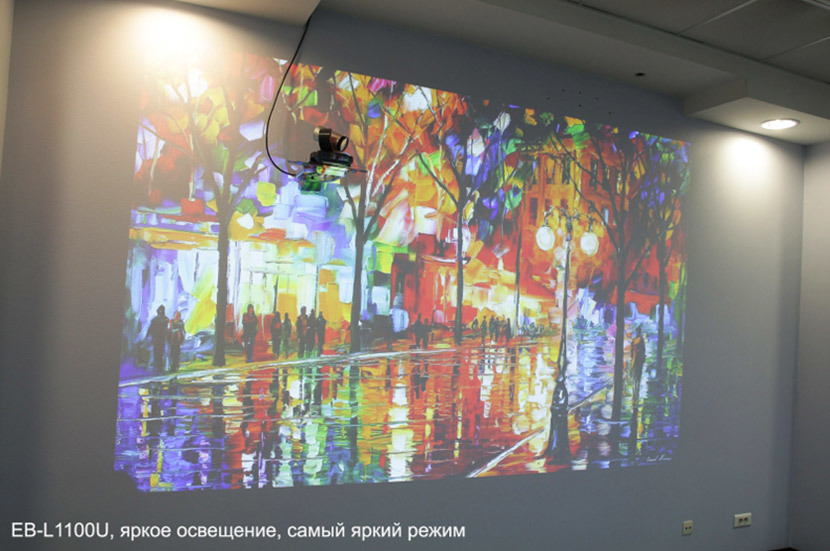


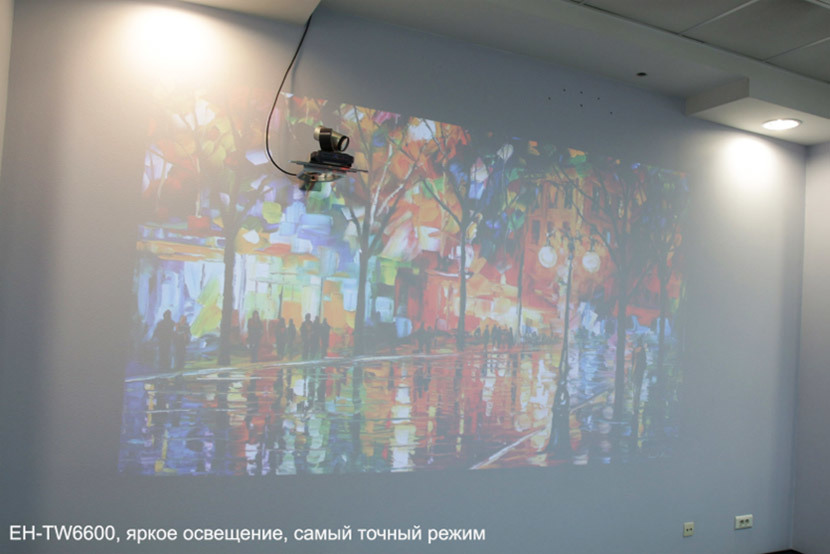
We have repeatedly stressed that in a lighted room more contrast is the projector, which is brighter and can “kill” the background lighting, so there are no surprises. As a result, using the most accurate mode in such conditions does not make sense. Moreover, in it we lose the extra brightness, which oh so necessary to increase the contrast in our well-lit conference room.
Let me remind you once again that we measure the screen contrast with a diagonal of 140 inches . Taking into account the law of inverse squares, reducing the screen size even by 25% will give a significant increase in the brightness of the resulting image, which will allow to get a sufficiently contrast picture even in such, to put it mildly, difficult conditions.
Extinguish the light!
Let's take another series of shots, putting out some of the lighting lamps:

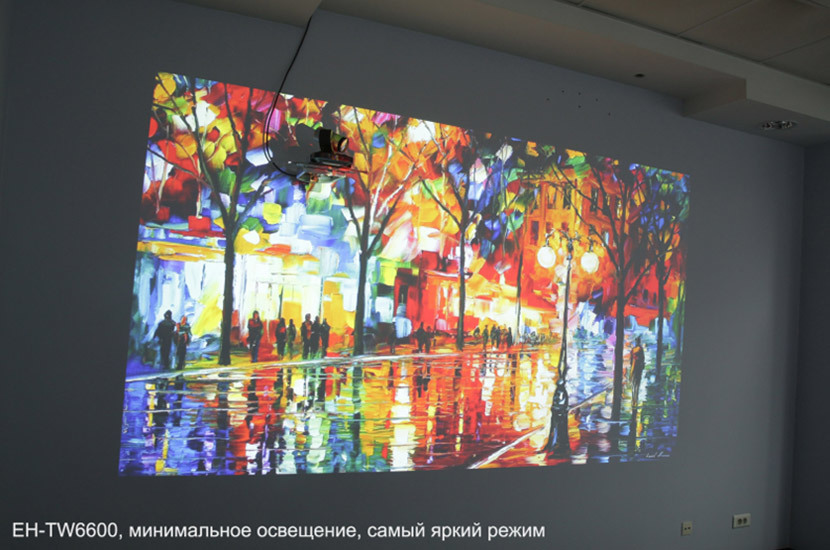
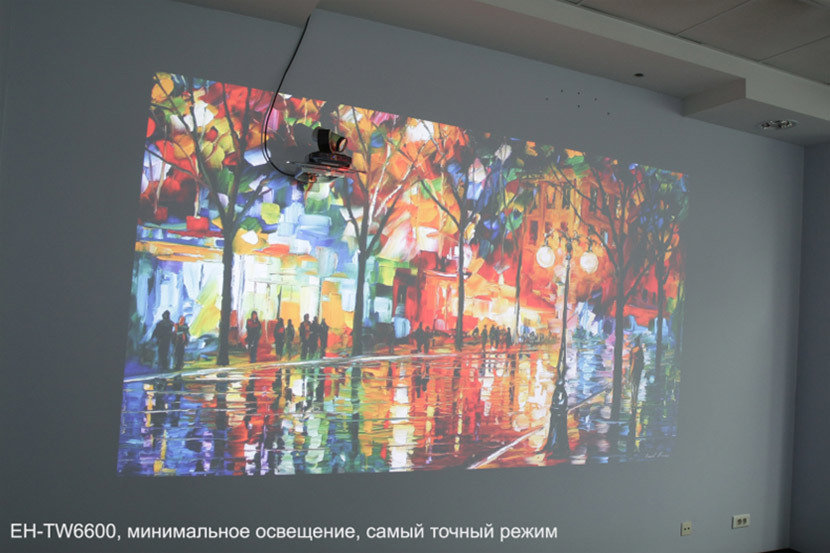
Much better! With a screen brightness of 23 lux, the obtained contrast levels are:
- 58: 1 (Epson EB-L1100U, maximum brightness)
- 29: 1 (Epson EH-TW6600, maximum brightness)
- 14: 1 (Epson EH-TW6600, sRGB)
Illumination of the working surface nearest to the screen - 39 lx, distant - 218:

Having glanced in Wikipedia , I have found out that just 30-50 lx is enough for reading. That is, it is also quite a lighted room. In this case, due to the intelligent separation of light sources near the screen, you can leave auxiliary lighting, in which the screen will be in the darkest part of the room, which gives a noticeable bonus to the contrast of the resulting image.
By the way, did you notice that you can’t say from the photo above that the difference between the two sections of the table in terms of illumination is so great? But for the quality of the projected image, this is a big difference, and it is obvious from which side to put the screen.
Illuminated - not necessarily re-lit
If the task is not to provide sufficient illumination for reading, then in order to properly navigate the room, 5 lux can be enough. Such illumination is typical for corridors in apartments and well-lit entrances. In fact, you can do even less ... and somewhere at this level of illumination the contrast of the projector itself will already begin to play a role, since the “black” screen on our already dimly lit light sources will be much darker, and the influence of the projector itself, its illumination, can make itself felt.
Of course, in complete darkness there is a chance to approach the level of contrast that the manufacturer claims (by the way, the Epson EB-L1100U laser has a stunning contrast thanks to a new light source).
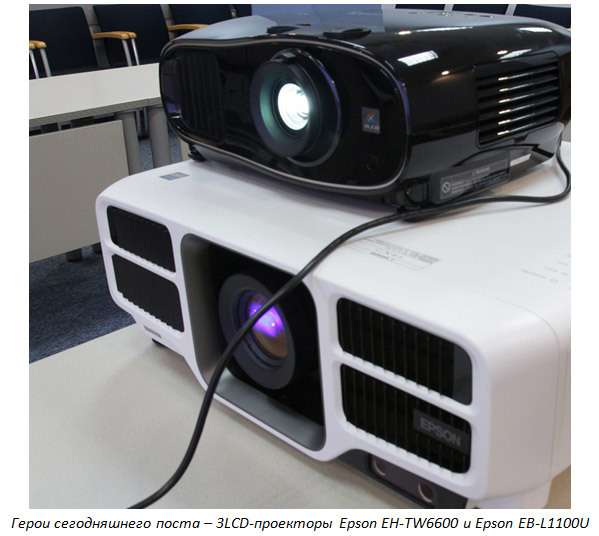
3LCD vs DLP. Again
If you want, beat them with sticks, but again you have to recall the fundamental difference between the 3LCD technologies (3 matrices) and DLP (1 matrix).
Why three-matrix projectors for illuminated rooms - the best choice? The fact is that the three-matrix technology (and we will not tire of repeating it) works simultaneously with three colors , immediately producing a color image, while one-matrix projectors work with one color at each time point, which reduces their efficiency and often forces them to resort to to enhance the white in order to achieve the same high passport brightness. Such color enhancement is achieved ... You guessed correctly - by increasing the proportion of white in the entire image. Here only the color areas get less light and the colors literally fade away.
I beg:
It turns out that a 3LCD projector and a one-matrix projector with the same lamp power can produce, for example, 3000 lumens for white , but the 3LCD projector will display so bright base colors (red, green, blue) that the sum of their brightness will also strive to 3000 lumens (which is logical). But a one-matrix projector in the brightest mode can produce 1500 lumens of color brightness, and maybe 1000 - as the manufacturer wants and depending on which color wheel is rotated in the selected projector model.
If you look at the image that we projected as an example, such a drop in color brightness will mean a fall in the contrast of the color areas of the image by a factor of 2-3 in the brightest mode, although the colorless areas will retain the same contrast. Here you have an advantage!
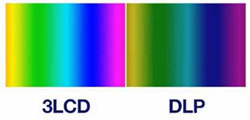
To be honest, I like the way Epson projectors have the picture in the brightest modes. The colors, of course, are not as correct as in the “most accurate” modes, but these most accurate modes do not look so spectacular in the conditions of a lighted room . And since there is no desire to switch from the bright mode to the exact one, then everything is done correctly!
Of course, one of the drawbacks of the image of any projector in a lit room is black (more precisely, its conditional absence), but the photographs we show show how black color becomes visually so if the adjacent image section is several times brighter. The eye is rebuilt on a bright one, and where the wall just lit up, a black color suddenly appears. We have already described one reason for this phenomenon, and it is of a purely optical nature.
But there is one more - more “psychological” character ...
Contrast illusion
At a certain threshold value of the difference between the dark and light areas of the image, the so-called an illusion with a shadow on a chessboard , when in reality the neighboring cells are just different shades of gray and the cell in the shadow appears lighter, while both cells have the same shade. All this is possible thanks to the peculiarities of our brain. And this is exactly the minimum level of contrast to which we aspire.

Totals
As for the contrast, the minimum value of the contrast of the image on which the text will be read is about 5: 1. And if you take the projector brighter and get the ratio of the bright light of the projector to the level of background lighting at 15: 1, then this is quite a nice looking picture on which you can watch, for example, TV shows, various different dynamic games and TV shows.
And even clearer
CnewsTV has a good video comparison of office projectors. If you do not be distracted by the difference in technology of the projectors under consideration, the review clearly shows that the most contrasting projector in the lit room turned out to be the brightest.
However, for us there is nothing new.
')
Source: https://habr.com/ru/post/369887/
All Articles